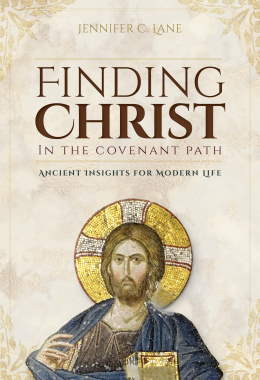Exploring Ancient Words
 We come unto Christ through the covenant path. Marianne von Werefkin, The Way of the Cross II, 1921. Museo Comunale d’Arte Moderna, Asconda. Permission granted by Cutler Miles Art Gallery, cutlermiles.com. © Cutler Miles Art Gallery.
We come unto Christ through the covenant path. Marianne von Werefkin, The Way of the Cross II, 1921. Museo Comunale d’Arte Moderna, Asconda. Permission granted by Cutler Miles Art Gallery, cutlermiles.com. © Cutler Miles Art Gallery.
It shouldn’t have been a surprise that the inspiration would come through music. As I was growing up in Arlington, Virginia, many moments of revelation and personal testimony came as I sang. As a young teenager singing an Easter Cantata with the ward choir, I felt the reality of the account in the lyrics that “very early in the morning, on the first day of the week, the women came to the sepulchre” and found that he was not here, but “was risen as they said.” A couple years later “A Poor Wayfaring Man of Grief” was the closing hymn in a meeting where Elder Oaks had given an apostolic blessing. As I sang, I felt it was my own witness that “the tokens in his hands I knew; the Savior stood before mine eyes.”[1]
In my first year away from home, I sang the Duruflé Requiem with the Wellesley College Choir in Massachusetts, and tears fell from my eyes when I sang, “Agnus Dei, qui tollis peccata mundi,” and I received an additional witness that, as the text said, Christ was indeed the Lamb of God who had taken upon himself the sin of the world. A couple years later when I was in the Missionary Training Center, Elder Haight shared the experience of his vision of Christ on the cross that he had received while he was seriously unwell, and we then sang “I Believe in Christ.” I had to get tissues from the missionaries around me during the hymn because I was crying so hard from the witness I felt as I sang, “I believe in Christ; he ransoms me. From Satan’s grasp he sets me free.”[2]
So on a car trip with my family a year after returning from my mission to France, it wasn’t a surprise that I felt a spiritual witness and confirmation while singing about the Savior, but this time there was an additional impression. It was just after the end of the summer term at Brigham Young University, where I had transferred just before my sophomore year. At the end of my first year at school after my mission, I had gone home to Virginia for a short trip up to Church history sites with my parents and younger brother, who was preparing to start school at BYU that fall.
Our family had a “Christmas in August” tradition, and we were singing Christmas carols as we drove on August 25. As we sang the second verse of the carol “Far, Far Away on Judea’s Plains,” the words “sweet are these strains of redeeming love, message of mercy from heav’n above” brought with them a powerful spirit.[3] I felt an overwhelming confirmation of the reality of Christ’s redeeming love and also a sense that this was the topic for my thesis.
On that car trip I was looking ahead to my last year at BYU. I was a history major and would be writing an honors thesis that year. I had had a sense for a while that this was important, and I needed to give thought to what I should write about. Since my mission, I was looking for topics, focusing on religious history in my classes and papers, hoping to narrow my studies and to find something to pursue, but nothing had stood out so far.
Earlier that summer I worked as a custodian at the Missionary Training Center cafeteria after breakfast. Day after day, I pushed the vacuum along the carpet of the quiet dining halls, cleaning up Cap’n Crunch cereal crumbs and singing to myself, offering a prayer in my heart that the right topic would come.
When the impression about which topic to write on came while I was singing in the car, I was fortunate to have a notebook computer with an early version of scripture search software. I opened it up to do some research. I needed to find out just what redemption was and where it was found in the scriptures. As I searched, I realized—to my surprise—that terms related to redemption and redeem showed up overwhelmingly in the Old Testament, quite often in the Book of Mormon, and a few times in the New Testament and Doctrine and Covenants.
When I got back to Provo I made an appointment to talk with Stephen Ricks, a professor of Hebrew and one of the associate deans of the honors program, about working with me as my advisor on an ancient Near Eastern topic. He initially encouraged me to read a book about each of the major ancient Near Eastern civilizations and then to come back and talk about what I wanted to focus on. I dutifully went and looked at a number of books, but a week later I came back and finally had the courage to tell him that I wanted to study redemption in the ancient Near East and Old Testament.
His willing support gave me the courage to dig in. I studied the scholarship of key terms associated with redemption. I printed out all the scriptures with redemption or redeem in the Old Testament. I studied each of the passages in the Book of Mormon where these terms were found. Then one day, as I sat in the library and looked through the scripture printouts, something clicked. I started to see a pattern and a connection between redemption and covenant. In the Old Testament the Lord Jehovah is the Redeemer of Israel. In my studies I started to understand why and what that meant for them and for me.
This academic journey led to not only an honors thesis but also a publication in the Journal of Book of Mormon Studies[4] and a presentation and publication in the following year’s Sperry Symposium volume. Twelve years later that article was chosen for inclusion in Sperry Symposium Classics: The Old Testament, a collection of past articles dealing with topics from the Old Testament.[5] My academic journey to understand redemption and the Lord’s role as our Redeemer also led to a master’s thesis on New Testament aspects of the theme and, over the years, several additional publications on dimensions of this topic related to the New Testament, Book of Mormon, Pearl of Great Price, and Doctrine and Covenants. As a professor of religious education at BYU–Hawaii, I have had the chance to do additional word studies and publications on other ancient words and phrases with deep and relevant meanings: worship, the presence of God, and sitting down enthroned. These words and concepts, understood in their ancient setting, weave together with the concepts of covenant and redemption to describe our covenant path back to God.
I will always be grateful for the witness I felt as I sang “the song of redeeming love” that summer on a family car trip along the East Coast (Alma 5:26). The journey of my life has been interwoven with the concepts that I have learned. Sometimes the experiences helped me to see the concepts and sometimes the concepts helped me to live through the experiences. I am grateful for the privilege to have spent so much of my life combining academic and personal study of the gospel. The love and witness I have felt through these studies has guided my life; I would like to share some of what I have learned with you here.
Notes
[1] James Montgomery, “A Poor Wayfaring Man of Grief,” in Hymns (Salt Lake City: The Church of Jesus Christ of Latter-day Saints, 1985), no. 29.
[2] Bruce R. McConkie, “I Believe in Christ,” in Hymns, no. 134.
[3] John M. Macfarlane, “Far, Far Away on Judea’s Plains,” in Hymns, no. 212.
[4] Jennifer C. Lane, “The Lord Will Redeem His People: ‘Adoptive’ Covenant and Redemption in the Old Testament and the Book of Mormon,” Journal of Book of Mormon Studies 2, no. 2 (1993): 39–62.
[5] Jennifer C. Lane, “The Lord Will Redeem His People: Adoptive Covenant and Redemption in the Old Testament,” in Sperry Symposium Classics: The Old Testament, ed. Paul Y. Hoskisson (Salt Lake City: Deseret Book; and Provo, UT: Religious Studies Center, Brigham Young University, 2005), 298–310.
